TiO2 Catalyzed Dihydroxyacetone (DHA) Conversion in Water: Evidence That This Model Reaction Probes Basicity in Addition to Acidity
Abstract
1. Introduction
2. Results and Discussion
2.1. Catalysts Characterization
2.2. Catalysts’ Acidity
2.3. Catalysts Basicity
2.4. DHA Conversion in Water
3. Materials and Methods
3.1. Commercial Titanium Dioxide (TiO2)
3.2. X-ray Diffraction (XRD)
3.3. Brunauer–Emmett–Teller Surface Area (SBET) Analysis and Pores’ Size Distribution
3.4. Pyridine Adsorption Monitored by Fourier Transform Infrared Spectroscopy (FTIR)
3.5. NH3 Adsorption Monitored by Microcalorimetry
3.6. CO2 Adsorption Monitored by Microcalorimetry
3.7. Dihydroxyacetone (DHA) Conversion in Water
4. Conclusions
- -
- The water tolerance of TiO2 superficial acidity as regards to triose conversion would require a minimum Lewis acid sites density with enough acid strength (QdiffNH3 > 130 kJ.mol−1).
- -
- The TiO2 basic sites would be water tolerant whatever their original basic strength.
Supplementary Materials
Author Contributions
Funding
Data Availability Statement
Conflicts of Interest
Sample Availability
References
- Damjanović, L.; Auroux, A. Determination of Acid/Base Properties by Temperature Programmed Desorption (TPD) and Adsorption Calorimetry. In Zeolite Chemistry and Catalysis; Chester, A.W., Derouane, E.G., Eds.; Springer Netherlands: Dordrecht, The Netherlands, 2009; pp. 107–167. ISBN 978-1-4020-9677-8. [Google Scholar]
- Hunger, B.; Hoffmann, J. Temperature-Programmed Desorption (TPD) of Ammonia from H+-Exchanged Zeolites with Different Structures. J. Therm. Anal. 1988, 33, 933–940. [Google Scholar] [CrossRef]
- Che, M.; Vedrine, J.C. Characterization of Solid Materials and Heterogeneous Catalysts: From Structure to Surface Reactivity; John Wiley & Sons: Hoboken, NJ, USA, 2012; ISBN 978-3-527-64533-6. [Google Scholar]
- Karge, H.G. Concepts and Analysis of Surface Acidity and Basicity. In Handbook of Heterogeneous Catalysis; Wiley-VCH: Weinheim, Germany, 2008; Volume 2, pp. 1096–1122. ISBN 978-3-527-61004-4. [Google Scholar]
- Auroux, A. Acidity and Basicity: Determination by Adsorption Microcalorimetry. In Acidity and Basicity; Molecular Sieves; Springer Berlin Heidelberg: Berlin/Heidelberg, Germany, 2006; Volume 6, pp. 45–152. ISBN 978-3-540-73963-0. [Google Scholar]
- Knözinger, H. Infrared Spectroscopy for the Characterization of Surface Acidity and Basicity. In Handbook of Heterogeneous Catalysis; American Cancer Society: Atlanta, GA, USA, 2008; pp. 1135–1163. ISBN 978-3-527-61004-4. [Google Scholar]
- Hara, M. Heterogeneous Lewis Acid Catalysts Workable in Water. Bull. Chem. Soc. Jpn. 2014, 87, 931–941. [Google Scholar] [CrossRef]
- Wang, Z.; Fongarland, P.; Lu, G.; Essayem, N. Reconstructed La-, Y-, Ce-Modified MgAl-Hydrotalcite as a Solid Base Catalyst for Aldol Condensation: Investigation of Water Tolerance. J. Catal. 2014, 318, 108–118. [Google Scholar] [CrossRef]
- Guisnet, M.; Pinard, L. Characterization of Acid-Base Catalysts through Model Reactions. Catal. Rev. 2018, 60, 337–436. [Google Scholar] [CrossRef]
- Guisnet, M.; Bichon, P.; Gnep, N.S.; Essayem, N. Transformation of Propane, n-Butane and n-Hexane over H3PW12O40 and Cesium Salts. Comparison to Sulfated Zirconia and Mordenite Catalysts. Top. Catal. 2000, 11, 247–254. [Google Scholar] [CrossRef]
- Essayem, N.; Ben Taârit, Y.; Feche, C.; Gayraud, P.Y.; Sapaly, G.; Naccache, C. Comparative Study of N-Pentane Isomerization over Solid Acid Catalysts, Heteropolyacid, Sulfated Zirconia, and Mordenite: Dependence on Hydrogen and Platinum Addition. J. Catal. 2003, 219, 97–106. [Google Scholar] [CrossRef]
- Drouilly, C.; Krafft, J.-M.; Averseng, F.; Lauron-Pernot, H.; Bazer-Bachi, D.; Chizallet, C.; Lecocq, V.; Costentin, G. Role of Oxygen Vacancies in the Basicity of ZnO: From the Model Methylbutynol Conversion to the Ethanol Transformation Application. Appl. Catal. Gen. 2013, 453, 121–129. [Google Scholar] [CrossRef]
- Frey, A.M.; Yang, J.; Feche, C.; Essayem, N.; Stellwagen, D.R.; Figueras, F.; de Jong, K.P.; Bitter, J.H. Influence of Base Strength on the Catalytic Performance of Nano-Sized Alkaline Earth Metal Oxides Supported on Carbon Nanofibers. J. Catal. 2013, 305, 1–6. [Google Scholar] [CrossRef]
- Karaki, M.; Karout, A.; Toufaily, J.; Rataboul, F.; Essayem, N.; Lebeau, B. Synthesis and Characterization of Acidic Ordered Mesoporous Organosilica SBA-15: Application to the Hydrolysis of Cellobiose and Insight into the Stability of the Acidic Functions. J. Catal. 2013, 305, 204–216. [Google Scholar] [CrossRef]
- Mei, D.; Lercher, J.A. Effects of Local Water Concentrations on Cyclohexanol Dehydration in H-BEA Zeolites. J. Phys. Chem. C 2019, 123, 25255–25266. [Google Scholar] [CrossRef]
- Jolimaitre, E.; Delcroix, D.; Essayem, N.; Pinel, C.; Besson, M. Dihydroxyacetone Conversion into Lactic Acid in an Aqueous Medium in the Presence of Metal Salts: Influence of the Ionic Thermodynamic Equilibrium on the Reaction Performance. Catal. Sci. Technol. 2018, 8, 1349–1356. [Google Scholar] [CrossRef]
- Vilcocq, L.; Koerin, R.; Cabiac, A.; Especel, C.; Lacombe, S.; Duprez, D. New Bifunctional Catalytic Systems for Sorbitol Transformation into Biofuels. Appl. Catal. B Environ. 2014, 148–149, 499–508. [Google Scholar] [CrossRef]
- Taarning, E.; Saravanamurugan, S.; Spangsberg Holm, M.; Xiong, J.; West, R.M.; Christensen, C.H. Zeolite-Catalyzed Isomerization of Triose Sugars. Chem. Sustain. Energy Mater. 2009, 2, 625–627. [Google Scholar] [CrossRef]
- Hossain, M.A.; Mills, K.N.; Molley, A.M.; Rahaman, M.S.; Talaphol, S.; Lalvani, S.B.; Dong, J.; Sunkara, M.K.; Sathitsuksanoh, N. Catalytic isomerization of dihydroxyacetone to lactic acid by heat treated zeolites. Appl. Catal. A Gen. 2021, 611, 117979. [Google Scholar] [CrossRef]
- Koito, Y.; Nakajima, K.; Kitano, M.; Hara, M. Efficient Conversion of Pyruvic Aldehyde into Lactic Acid by Lewis Acid Catalyst in Water. Chem. Lett. 2013, 42, 873–875. [Google Scholar] [CrossRef]
- Albuquerque, E.M.; Borges, L.E.P.; Fraga, M.A.; Sievers, C. Relationship between Acid-Base Properties and the Activity of ZrO2-Based Catalysts for the Cannizzaro Reaction of Pyruvaldehyde to Lactic Acid. ChemCatChem 2017, 9, 2675–2683. [Google Scholar] [CrossRef]
- Santos, K.M.A.; Albuquerque, E.M.; Borges, L.E.P.; Fraga, M.A. Discussing Lewis and Brønsted Acidity on Continuous Pyruvaldehyde Cannizzaro Reaction to Lactic Acid over Solid Catalysts. Mol. Catal. 2018, 458, 198–205. [Google Scholar] [CrossRef]
- Innocenti, G.; Papadopoulos, E.; Fornasari, G.; Cavani, F.; Medford, A.J.; Sievers, C. Continuous Liquid-Phase Upgrading of Dihydroxyacetone to Lactic Acid over Metal Phosphate Catalysts. ACS Catal. 2020, 10, 11936–11950. [Google Scholar] [CrossRef]
- Nakajima, K.; Noma, R.; Kitano, M.; Hara, M. Titania as an Early Transition Metal Oxide with a High Density of Lewis Acid Sites Workable in Water. J. Phys. Chem. C 2013, 117, 16028–16033. [Google Scholar] [CrossRef]
- West, R.M.; Holm, M.S.; Saravanamurugan, S.; Xiong, J.; Beversdorf, Z.; Taarning, E.; Christensen, C.H. Zeolite H-USY for the Production of Lactic Acid and Methyl Lactate from C3-Sugars. J. Catal. 2010, 269, 122–130. [Google Scholar] [CrossRef]
- Sobus, N.; Krol, M.; Piotrowski, M.; Michorczyk, B.; Czekaj, I.; Kornaus, K.; Trenczek-Zajac, A.; Komarek, S. Conversion of dihydroxyacatone to carboxylic acids on pretreated clinoptilonite modified with iron, copper, and cobalt. Catal. Commun. 2022, 171, 106509. [Google Scholar] [CrossRef]
- Takagaki, A.; Goto, H.; Kikuchi, R.; Oyama, S.T. Silica-supported chromia-titania catalysts for selective formation of lactic acid from a trise in water. Appl. Catal. A Gen. 2019, 570, 200–208. [Google Scholar] [CrossRef]
- Komanoya, T.; Suzuki, A.; Nakajima, K.; Kitano, M.; Kamata, K.; Hara, M. A Combined Catalyst of Pt Nanoparticles and TiO2 with Water-Tolerant Lewis Acid Sites for One-Pot Conversion of Glycerol to Lactic Acid. ChemCatChem 2016, 8, 1094–1099. [Google Scholar] [CrossRef]
- Kulkarni, A.P.; Muggli, D.S. The Effect of Water on the Acidity of TiO2 and Sulfated Titania. Appl. Catal. Gen. 2006, 302, 274–282. [Google Scholar] [CrossRef]
- Silahua-Pavón, A.A.; Espinosa-González, C.G.; Ortiz-Chi, F.; Pacheco-Sosa, J.G.; Pérez-Vidal, H.; Arévalo-Pérez, J.C.; Godavarthi, S.; Torres-Torres, J.G. Production of 5-HMF from Glucose Using TiO2-ZrO2 Catalysts: Effect of the Sol-Gel Synthesis Additive. Catal. Commun. 2019, 129, 105723. [Google Scholar] [CrossRef]
- Vishwanathan, V.; Roh, H.-S.; Kim, J.-W.; Jun, K.-W. Surface Properties and Catalytic Activity of TiO2–ZrO2 Mixed Oxides in Dehydration of Methanol to Dimethyl Ether. Catal. Lett. 2004, 96, 23–28. [Google Scholar] [CrossRef]
- Araña, J.; Alonso, A.P.; Rodríguez, J.M.D.; Colón, G.; Navío, J.A.; Peña, J.P. FTIR Study of Photocatalytic Degradation of 2-Propanol in Gas Phase with Different TiO2 Catalysts. Appl. Catal. B Environ. 2009, 89, 204–213. [Google Scholar] [CrossRef]
- Busca, G. The Surface Acidity of Solid Oxides and Its Characterization by IR Spectroscopic Methods. An Attempt at Systematization. Phys. Chem. Chem. Phys. 1999, 1, 723–736. [Google Scholar] [CrossRef]
- Watanabe, M.; Aizawa, Y.; Iida, T.; Aida, T.M.; Levy, C.; Sue, K.; Inomata, H. Glucose Reactions with Acid and Base Catalysts in Hot Compressed Water at 473K. Carbohydr. Res. 2005, 340, 1925–1930. [Google Scholar] [CrossRef]
- Pichat, P. Contribution à L’étude de L’adsorption de L’ammoniac et de la Pyridine Sur des Oxydes Isolants à l’aide de la Spectrométrie Infra-Rouge; Lyon I University: Lyon, France, 1966. [Google Scholar]
- Souza, R.O.L.; Fabiano, D.P.; Feche, C.; Rataboul, F.; Cardoso, D.; Essayem, N. Glucose–Fructose Isomerisation Promoted by Basic Hybrid Catalysts. Catal. Today 2012, 195, 114–119. [Google Scholar] [CrossRef]
- Moreau, C.; Lecomte, J.; Roux, A. Determination of the Basic Strength of Solid Catalysts in Water by Means of a Kinetic Tracer. Catal. Commun. 2006, 7, 941–944. [Google Scholar] [CrossRef]
- Nakajima, K.; Hirata, J.; Kim, M.; Gupta, N.K.; Murayama, T.; Yoshida, A.; Hiyoshi, N.; Fukuoka, A.; Ueda, W. Facile Formation of Lactic Acid from a Triose Sugar in Water over Niobium Oxide with a Deformed Orthorhombic Phase. ACS Catal. 2018, 8, 283–290. [Google Scholar] [CrossRef]
- Palai, Y.N.; Shrotri, A.; Asakawa, M.; Fukuoka, A. Silica Supported Sn Catalysts with Tetrahedral Sn Sites for Selective Isomerization of Glucose to Fructose. Catal. Today 2021, 365, 241–248. [Google Scholar] [CrossRef]
- Abdouli, I.; Eternot, M.; Dappozze, F.; Guillard, C.; Essayem, N. Comparison of Hydrothermal and Photocatalytic Conversion of Glucose with Commercial TiO2: Superficial Properties-Activities Relationships. Catal. Today 2020, 367, 268–277. [Google Scholar] [CrossRef]
- Doiseau, A.C.; Rataboul, F.; Burel, L.; Essayem, N. Synergy Effect between Solid Acid Catalysts and Concentrated Carboxylic Acids Solutions for Efficient Furfural Production from Xylose. Catal. Today 2014, 226, 176–184. [Google Scholar] [CrossRef]
- Wang, Z.; Fongarland, P.; Lu, G.; Zhan, W.; Essayem, N. Effect of Hydration on the Surface Basicity and Catalytic Activity of Mg-Rare Earth Mixed Oxides for Aldol Condensation. J. Rare Earths 2018, 36, 359–366. [Google Scholar] [CrossRef]
- Desmartin-Chomel, A.; Hamad, B.; Palomeque, J.; Essayem, N.; Bergeret, G.; Figueras, F. Basic Properties of MgLaO Mixed Oxides as Determined by Microcalorimetry and Kinetics. Catal. Today 2010, 152, 110–114. [Google Scholar] [CrossRef]

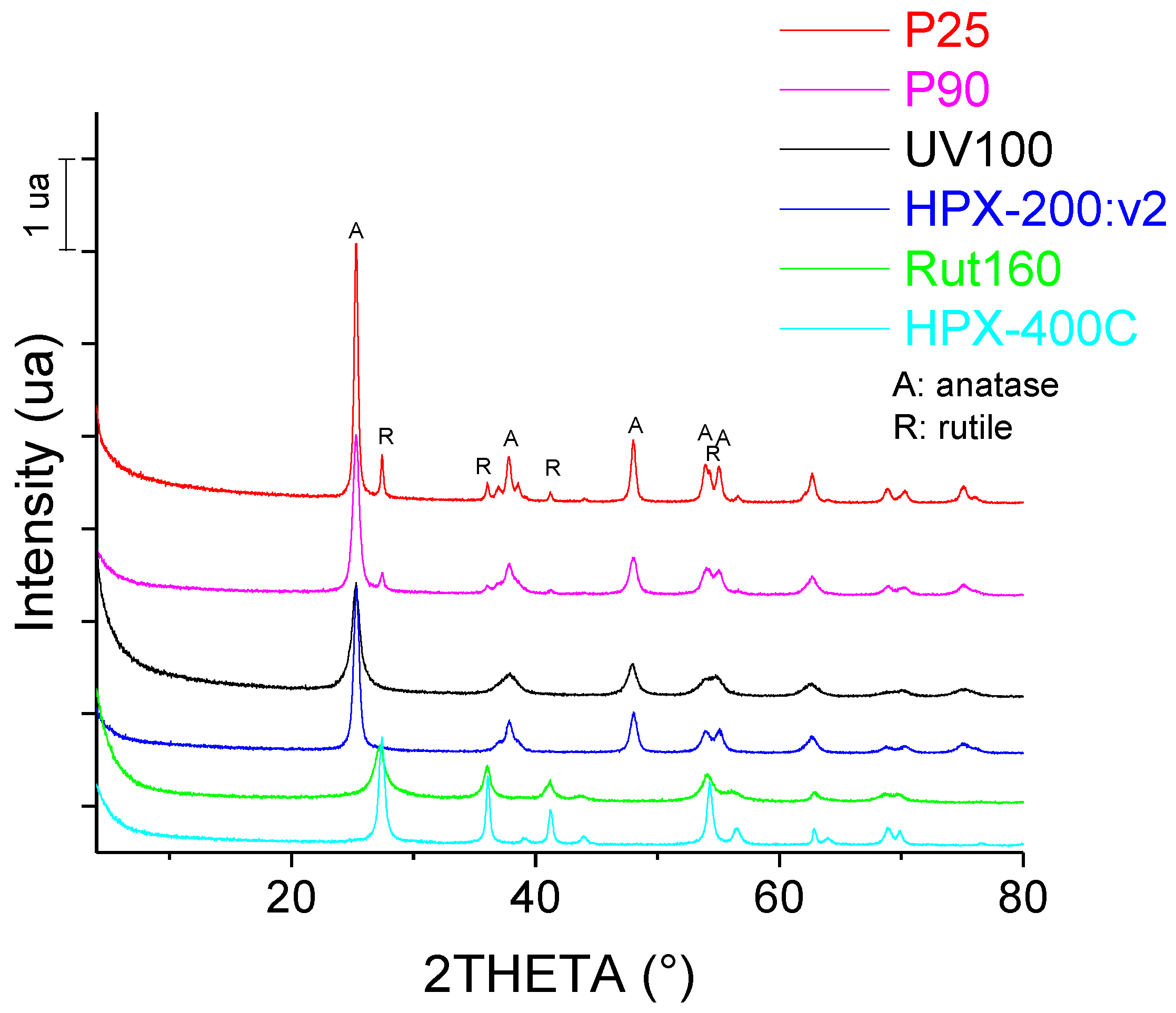
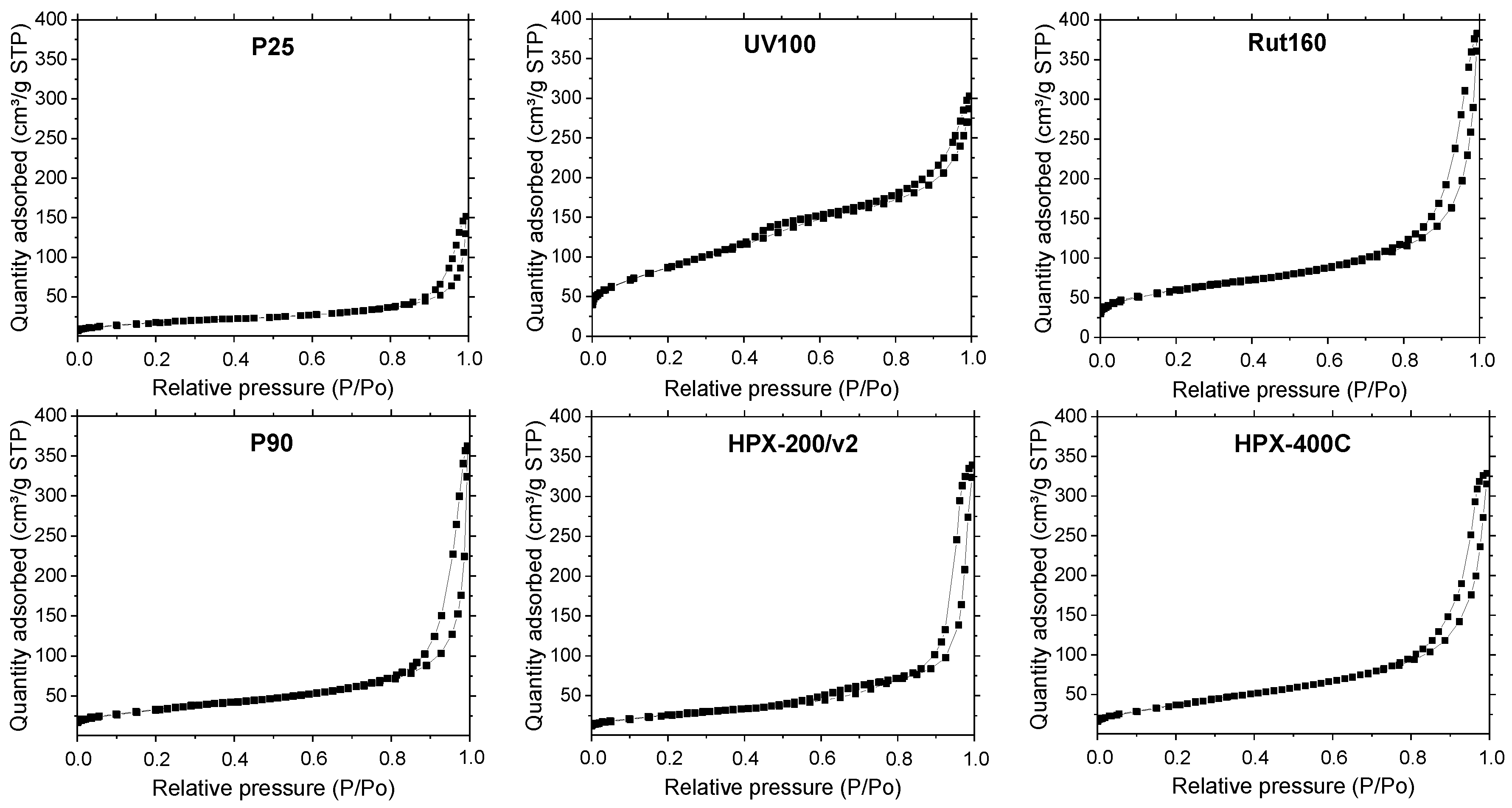

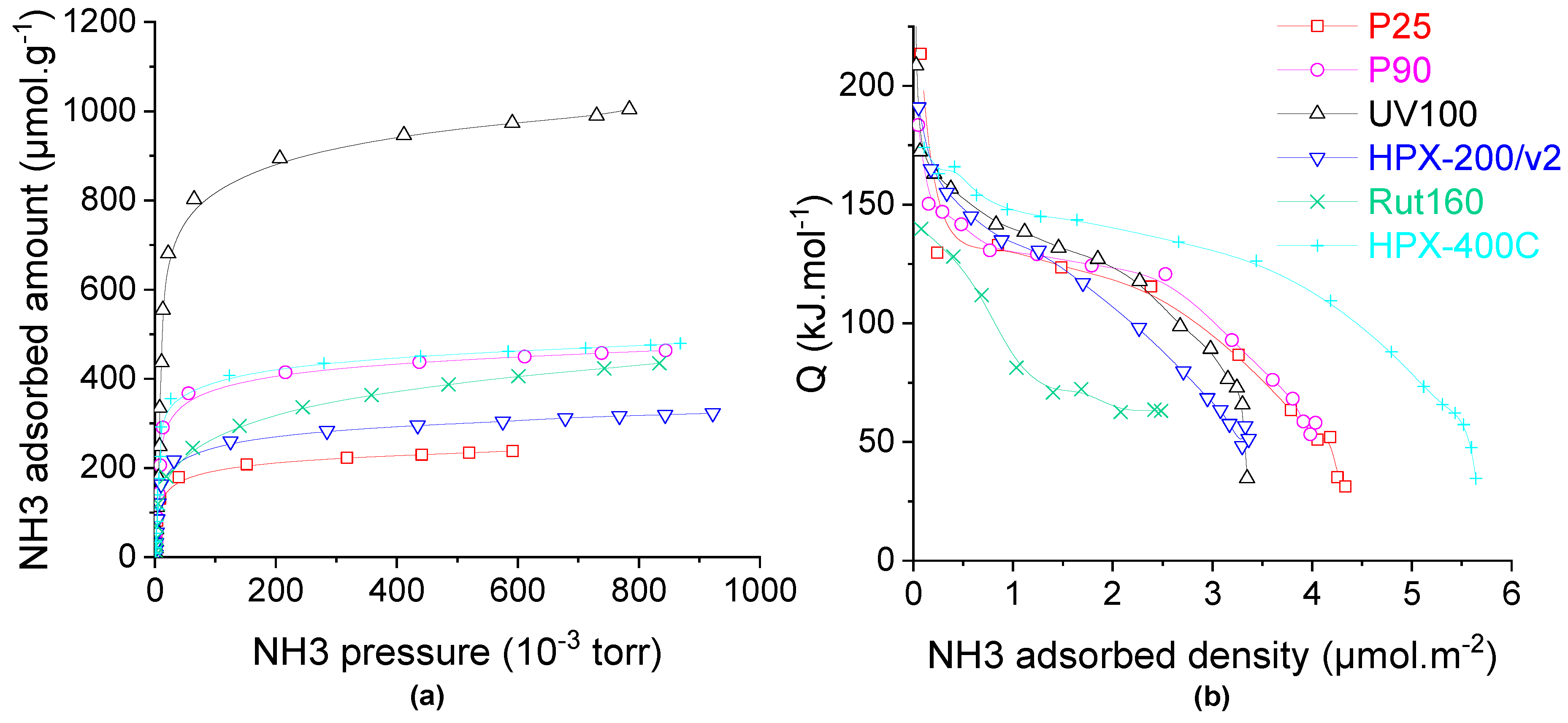
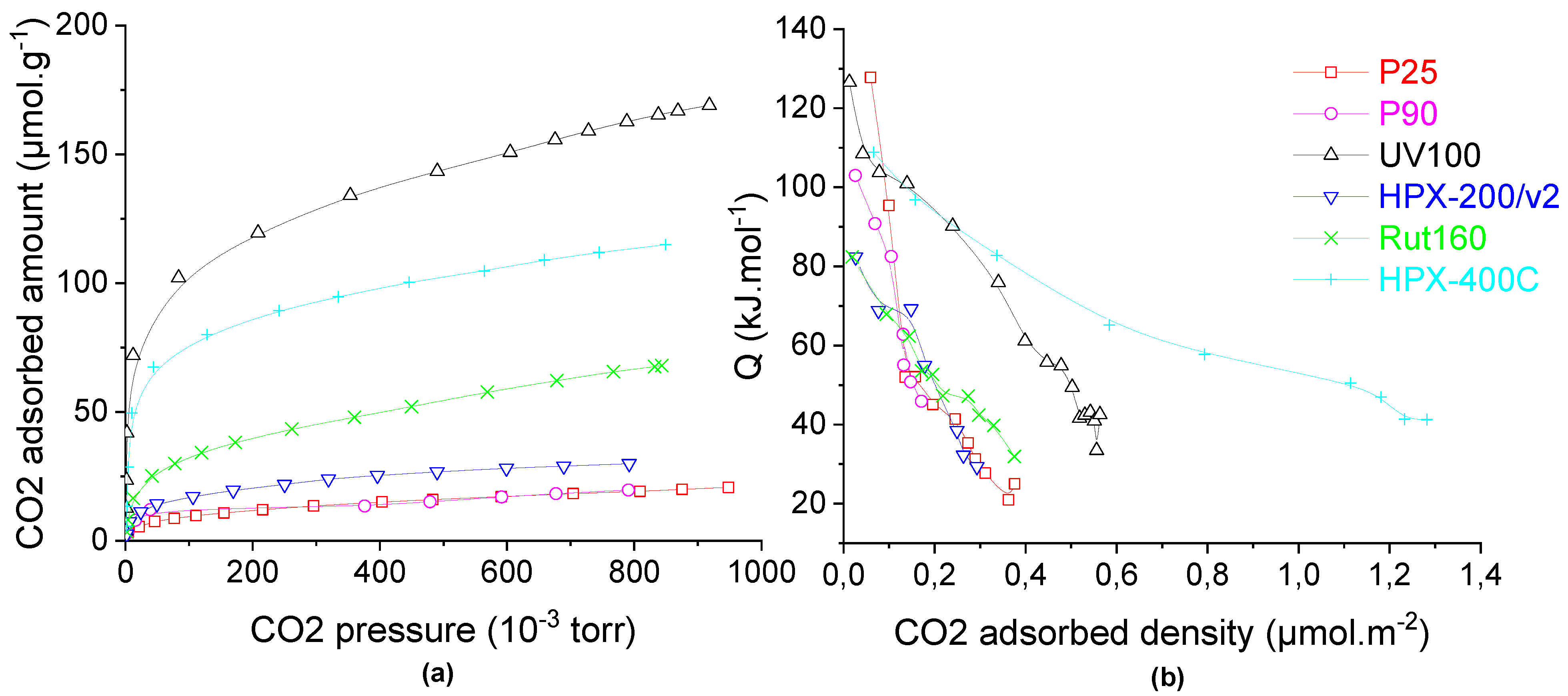

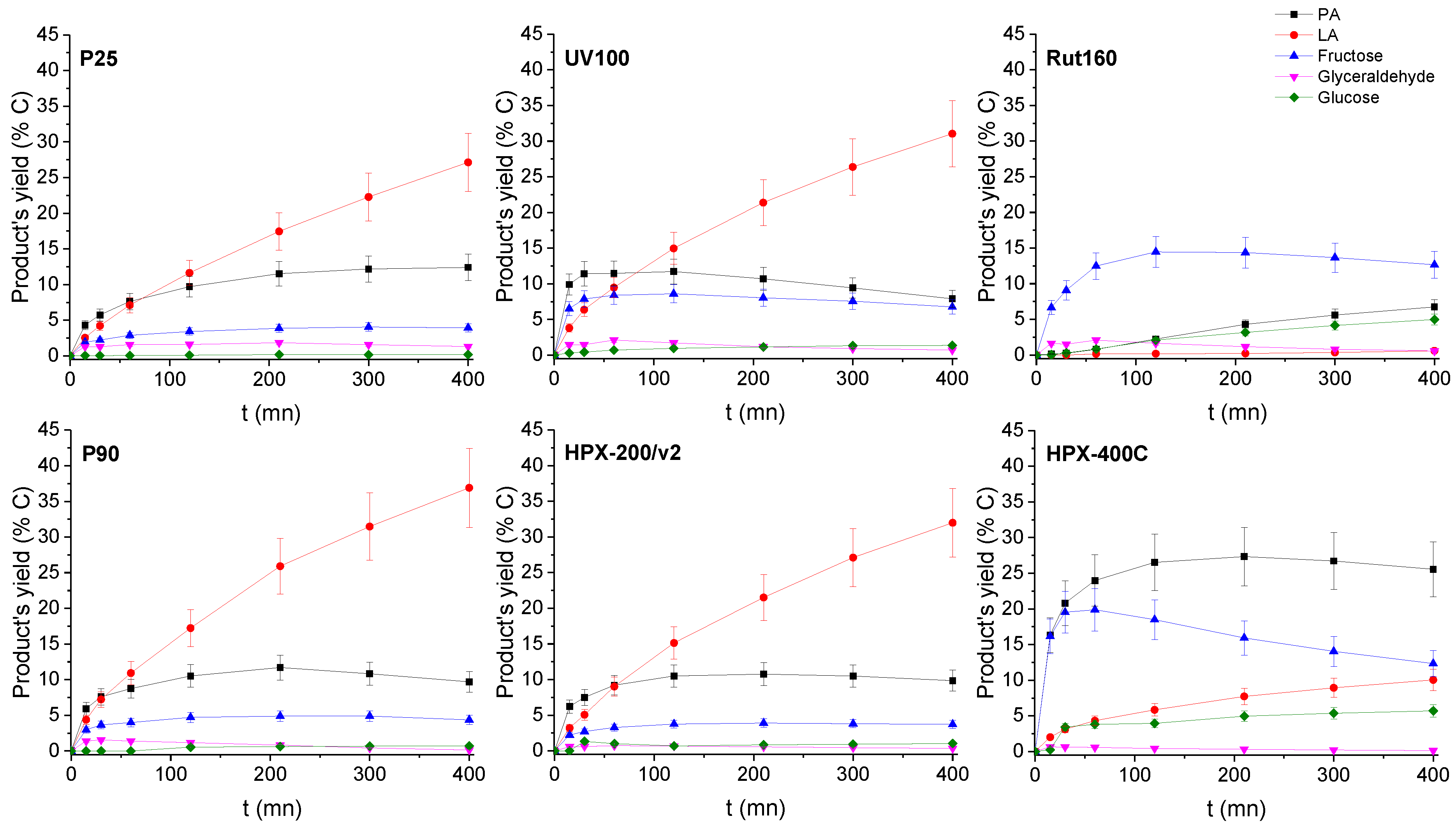

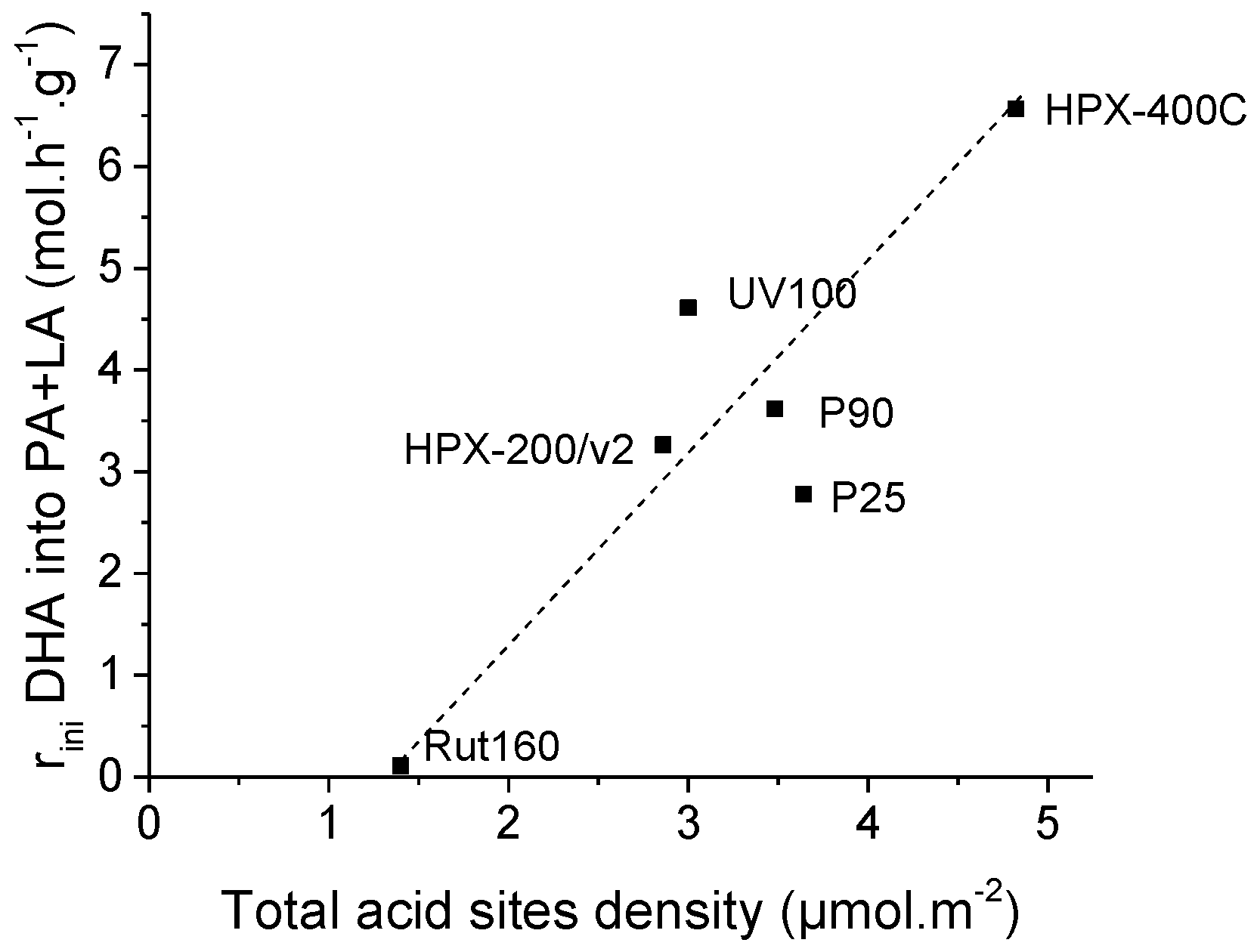
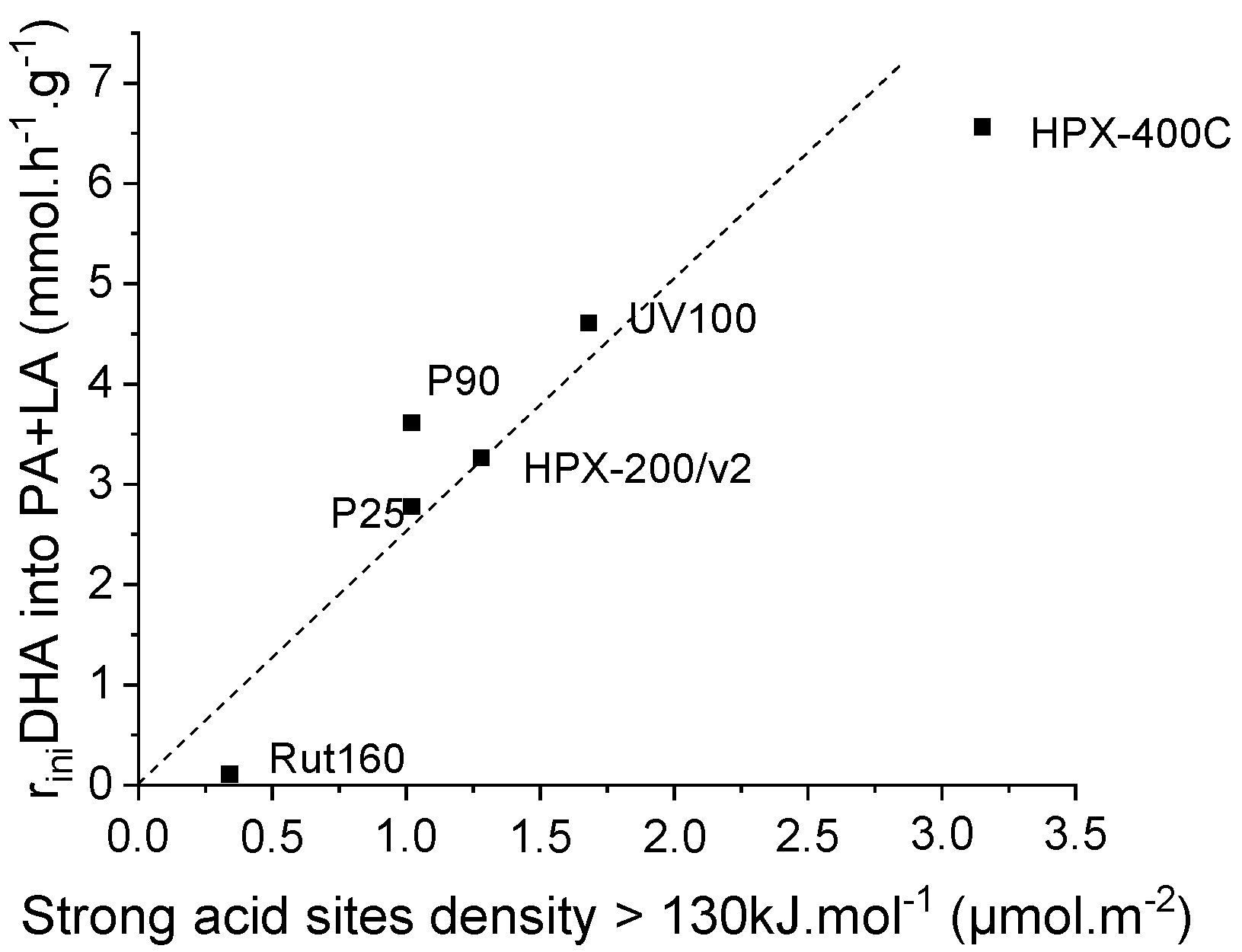




| Catalysts | SBET 1 (m2.g−1) | Mesopores Size 2 | S Micropore 3 (m2.g−1) | Crystallites Size 4 (nm) |
|---|---|---|---|---|
| P25 (80% anatase/20% rutile) | 55 | >4 nm | - | 18.1 |
| P90 (92% anatase/8% rutile) | 115 | >5 nm | - | 11.6 |
| UV100 | 300 | >3 nm | 194 | 7.5 |
| HPX-200/v2 | 96 | >4 nm | - | 13.1 |
| Rut160 | 175 | >4 nm | 82 | 8.5 |
| HPX-400C | 85 | >5 nm | - | 16.4 |
| Catalyst | Acid Sites Amount (µmol.g−1) | Acid Sites Density (µmol.m−2) | Basic Sites Amount (µmol.g−1) | Basic Sites Density (µmol.m−2) | Acid/Base Sites Ratio |
|---|---|---|---|---|---|
| P25 | 200 | 3.6 | 10 | 0.18 | 20 |
| P90 | 400 | 3.5 | 15 | 0.13 | 27 |
| UV100 | 900 | 3 | 120 | 0.4 | 7.5 |
| HPX-200/v2 | 275 | 2.9 | 20 | 0.2 | 13.7 |
| Rut160 | 240 | 1.4 | 40 | 0.23 | 6 |
| HPX-400C | 410 | 4.8 | 85 | 1 | 4.8 |
Publisher’s Note: MDPI stays neutral with regard to jurisdictional claims in published maps and institutional affiliations. |
© 2022 by the authors. Licensee MDPI, Basel, Switzerland. This article is an open access article distributed under the terms and conditions of the Creative Commons Attribution (CC BY) license (https://creativecommons.org/licenses/by/4.0/).
Share and Cite
Abdouli, I.; Dappozze, F.; Eternot, M.; Guillard, C.; Essayem, N. TiO2 Catalyzed Dihydroxyacetone (DHA) Conversion in Water: Evidence That This Model Reaction Probes Basicity in Addition to Acidity. Molecules 2022, 27, 8172. https://doi.org/10.3390/molecules27238172
Abdouli I, Dappozze F, Eternot M, Guillard C, Essayem N. TiO2 Catalyzed Dihydroxyacetone (DHA) Conversion in Water: Evidence That This Model Reaction Probes Basicity in Addition to Acidity. Molecules. 2022; 27(23):8172. https://doi.org/10.3390/molecules27238172
Chicago/Turabian StyleAbdouli, Insaf, Frederic Dappozze, Marion Eternot, Chantal Guillard, and Nadine Essayem. 2022. "TiO2 Catalyzed Dihydroxyacetone (DHA) Conversion in Water: Evidence That This Model Reaction Probes Basicity in Addition to Acidity" Molecules 27, no. 23: 8172. https://doi.org/10.3390/molecules27238172
APA StyleAbdouli, I., Dappozze, F., Eternot, M., Guillard, C., & Essayem, N. (2022). TiO2 Catalyzed Dihydroxyacetone (DHA) Conversion in Water: Evidence That This Model Reaction Probes Basicity in Addition to Acidity. Molecules, 27(23), 8172. https://doi.org/10.3390/molecules27238172







